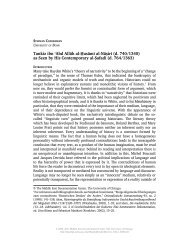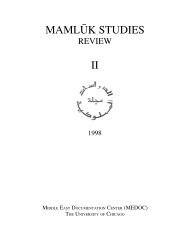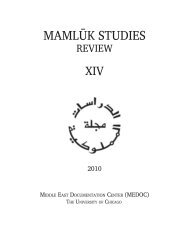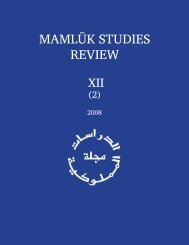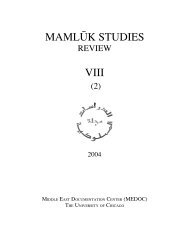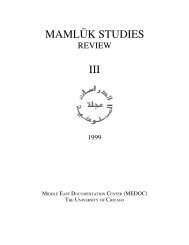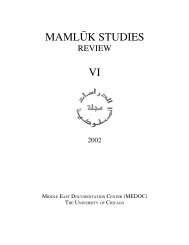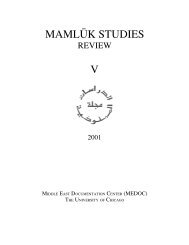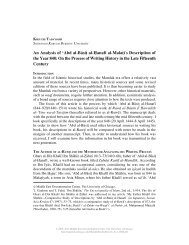Mamluk Studies Review Vol. IV (2000)
Mamluk Studies Review Vol. IV (2000)
Mamluk Studies Review Vol. IV (2000)
You also want an ePaper? Increase the reach of your titles
YUMPU automatically turns print PDFs into web optimized ePapers that Google loves.
40 ROBERT IRWIN, UNDER WESTERN EYES<br />
to chambers of aldermen or guilds. Muslim Cities has been widely and rightly<br />
praised.<br />
At the same time, it attracted criticism and debate. Lapidus had studied the<br />
<strong>Mamluk</strong> city rather than the Muslim city. As a heuristic device, Lapidus had<br />
constructed a Weberian "ideal type" of Islamic city in order to compare it with the<br />
European city. But one might as well compare the cities Lapidus had studied with<br />
Samarkand, Tabriz, and Fez in the same period, for there were many significant<br />
dissimilarities. It was not even clear to what extent Lapidus's insights applied to<br />
Egyptian cities. He had sometimes had recourse to Egyptian data, but he did not<br />
come up with Egyptian conclusions. He had, on the whole, taken a synchronic<br />
approach to the subject, which meant that the book failed to register distinctly the<br />
impact on the Syrian cities of the Black Death or of the expansion of Venetian<br />
trade.<br />
Lapidus (and others after him, including R. S. Humphreys) stressed the<br />
overwhelming role of <strong>Mamluk</strong> patronage. But it is natural for cultural historians<br />
to go looking for a role for the bourgeoisie here. (After all, most historians these<br />
days have bourgeois origins and therefore there is perhaps a certain parti pris.)<br />
Oleg Grabar has argued that what little evidence we have suggests that the bourgeois<br />
were the chief patrons of the illustrated Maqa≠ma≠ts which are such a feature of the<br />
age. Less plausibly, Grabar has assigned a role for the bourgeois in the construction<br />
of the Sultan H˛asan Mosque. How, he asked, did such a very weak ruler as<br />
al-Na≠s˝ir H˛asan find the resources to build the greatest madrasah in Cairo? Grabar<br />
suggested that the grand bourgeoisie was the real builders. The <strong>Mamluk</strong>s were in<br />
shaky control whereas the urban bourgeoisie "had considerable financial and<br />
bureaucratic power within the state." (It is not an argument which has much in the<br />
way of evidence to recommend it.) Once built, the Sultan H˛asan Mosque became<br />
a monument for popular piety and a focus for legend. 41<br />
In 1974 at the request of MESA, Albert Hourani prepared a report on "The<br />
Present State of Islamic and Middle Eastern Historiography." Hourani's tour<br />
d'horizon is full of interest, but I restrict myself here to what he said about<br />
<strong>Mamluk</strong> studies: "for the <strong>Mamluk</strong>s of Egypt even the basic institution, the military<br />
society, has not yet been studied, although Ayalon has laid very solid foundations<br />
and Darrag has studied one reign in depth." 42 Hourani based himself on the<br />
Gunpowder monograph plus "<strong>Studies</strong> in the Structure of the <strong>Mamluk</strong> Army" and I<br />
rather feel he underestimated the scope of Ayalon's publications. Additionally,<br />
41<br />
Oleg Grabar in J. R. Hayes, ed., The Genius of Arab Civilization: Source of Renaissance<br />
(Cambridge, MA, 1983), 108.<br />
42<br />
Albert Hourani, "The Present State of Islamic and Middle Eastern Historiography," reprinted in<br />
idem, Europe and the Middle East, 176.<br />
© <strong>2000</strong>, 2012 Middle East Documentation Center, The University of Chicago.<br />
http://mamluk.uchicago.edu/<strong>Mamluk</strong><strong>Studies</strong><strong>Review</strong>_<strong>IV</strong>_<strong>2000</strong>.pdf



